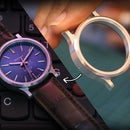Introduction: Make a Lithophane Lamp
Hello, Internet! A few days back I 3D printed my first lithophane which turned out great. It has been a while since I did a 3D printing project. So, I decided to make a lithophane lamp with pictures of my family. It is a simple and straight forward build. And my parents were impressed too!
Let's get started!
Supplies
- White PLA Filament
- 3D Printer
- 12V LED Strip (Warm White)
- 12V Power Supply
- DC Power Jack and Switch (Optional)
Step 1: The Plan
I have designed this simple structure in Fusion 360. The .STL files have been attached here.
We will be using an online lithophane generator to convert your 2D image into 3D lithophane. The structure holds 4 lithophanes in the front. Lithophane must be 50x50mm with a maximum thickness of 3mm and a border of 2mm.
Warm white 12V LED strips will be used to illuminate the lithophane from behind. The wiring of the LED strips can be neatly tucked into the channels provided and the cover makes sure that no wires are visible.
Step 2: Creating Lithophanes
Before creating lithophanes, we first need to prepare the image by cropping it square (1:1). This is important.
Turning images to lithophanes:
- Visit this online converter and upload your image in the 'Images' tab.
- Select Flat profile
- Go to Settings > Model Settings
- Set Maximum Size = 50mm, Thickness = 3mm, Border = 2mm
- Go to Settings > Image Settings
- Bring the slider to Positive image
Go back to the 'Models' tab, hit Refresh and download the STL file.
Step 3: 3D Printing
I have printed the parts using Creality Ender 3 with White PLA filament and 0.4mm nozzle diameter. The main body took approximately 14hrs to complete. So make sure your slicer settings are just right.
Slicer settings for printing the main body and cover -
- Layer height = 0.2 mm
- Wall thickness = 1.2 mm. I printed with 0.8mm which makes the infill more visible as light shines through it. It doesn't look that bad but it would have been better.
- Top thickness = 0.8 mm. The same applies here too.
- Infill = 15%
- Use Raft and heated bed to get good adhesion to the bed. I had first printed without any rafts and the print just lifted up at the edges as seen in the photo. Here's a good explanation by CNC Kitchen on prints lifting up
Slicer settings for printing lithophane -
- Layer height = 0.2 mm
- Infill = 100%
- Use Raft since the surface area in contact with the bed is very small
- All other settings don't really matter
Step 4: Assembly
The printed parts might need some sanding for a perfect fit.
Now, cut four equal sections of the LED strips such that it covers (or partially covers) the inside wall of the square and stick them as shown in the photo. I also used some super glue to stick the strips.
Next, route the wires through the channel provided. The LED strips need to be connected in parallel.
Hide the wiring with the cover. It should be a good friction fit.
Lastly, fix your four lithophanes in the front. Lithophanes might need a little bit of sanding for a good fit.
Step 5: Enjoy!
I have added a switch and a power jack in a case to make it neat. This is optional. Use a 12V power supply to power up the lights and enjoy your lamp!
Thank you for sticking to the end. I hope you all love this project and learned something new today. Let me know if you make one for yourself. Subscribe to my YouTube channel for more such projects.













